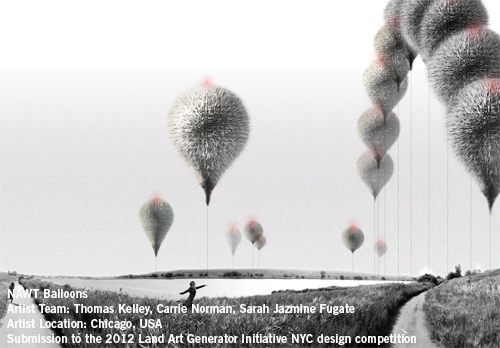NAWT Balloons
Submission to the 2012 Land Art Generator Initiative NYC design competition
Artist Team: Thomas Kelley, Carrie Norman, Sarah Jazmine Fugate
Artist Location: Chicago, USA

Artist Descriptive Text:
It is a common misconception that Phileas Fogg’s journey in Around the World in Eighty Days was by hot air balloon. The iconic image, however, fulfills a visual nostalgia for the whimsical beauty of a floating mass. Despite the misreading of Verne’s text, the image is far too satisfying to pass up and we accept the error. The aim of this project is to couple the image of an oversized helium-filled teardrop with a nuanced application of wind energy technology. While the balloon’s image and subsequent geometry are the primitives to our submission, the deployment on the Fresh Kills site ignites an interest in the oversized and the attenuated. Thousands of airborne wind turbines are embedded in conic hair follicles which are applied to the balloon’s curved surface. Skewing the iconic image of Verne’s bouyant transportation, the aim of NAWT Balloons is not flight or expedition. But through its multiplication and reconfiguration, it may be able to produce new, yet familiar, collections of iconicity. It is our belief that it is not important if the method of travel in Fogg’s journey is often depicted falsely, but rather that it continues to strike a chord with the eyes, both young and old.

Technical:
The hegemony of the Horizontal Axis Wind Turbine must end! Nuance and whimsy are not the enemies of efficiency!
Currently, in the developing wind energy industry, the iconic HAWT is prevalent. In part, the HAWT prevails because of the equation for the available energy in wind: Ek = ½ p A v3, where p is the air density, A is the part of the turbine swept by the wind, and v3 is the velocity of the wind. Since on any given site, designers can do little to control p and v, they have thus far focused on increasing the swept area, A. For a HAWT, A = ∏r2, so the industry has tended toward larger and larger turbines, because energy outputs are a function of the square of the radius of the turbine. Thus goes the conventional thinking that bigger is always better. If the question being asked is, “How can we make the most energy from a single wind turbine?” then such a response is the only logical one.

Yet, the bigger a HAWT is, the deeper and more intrusive its foundations must be and the more embodied energy it must contain. Furthermore, the bigger a HAWT is, the further it has to be spaced from other HAWTs to function efficiently. The Fresh Kills site, for example, can only host up to five large HAWTs, despite its sprawling size. What if the question asked were, “How can we achieve the greatest density of energy production on this site, with its given area and given three dimensional wind conditions?” When the question is posed in this more specific and nuanced way, we see that bigger is not necessarily denser.

The wind energy industry is starting to explore the idea of energy density in addition to exploring ways to increase the energy produced at any one point. Much research has been done (particularly by Professor John Dabiri at Caltech) to show that Vertical Axis Wind Turbines can nest more closely together than HAWTs, can turn in complementary directions, and can increase in efficiency without increasing their footprints by growing vertically. The swept area for a VAWT is A = rh, where r is the radius of the turbine and h is its height.
This project resists the simplicity of the thinking that has lead to HAWT dominance and uses the VAWT as a starting point. It is also highly influenced by the whimsy of Airborne Wind Turbines of all types–from the kytoon to the Magenn Air Rotor System.
The project proposes mounting an array of VAWT-style turbines to the surface of balloons, with each turbine held normal to the balloon’s surface. This new type of turbine, the Normal Axis Wind Turbine, adds a sculptural, whimsical quality to the surface of each balloon. The turbines are light, interchangeable, and have very low embodied energy. Because each balloon is held aloft by the buoyancy of helium gas, only minimal foundations are required for tie-downs, resulting in less disruption of the site. And though each turbine produces only a tiny fraction of the energy produced by a large HAWT, the turbines nest tightly together while minimally disrupting each other’s efficiencies.

Furthermore, the balloons’ height and cluster patterns can be adjusted to increase energy output as needed, since the balloons can be allowed to go higher to catch stronger winds and since adding more balloons to the same tie-down location is relatively simple.
Like so many examples from nature, the Normal Axis Wind Turbine balloon builds up to high energy output through density and cellularity.


